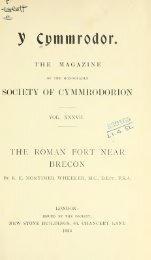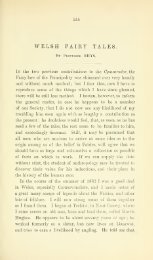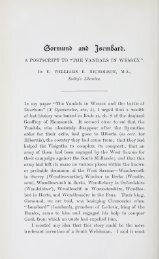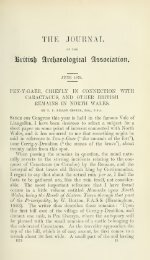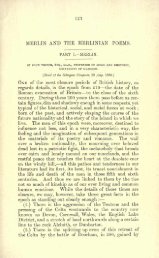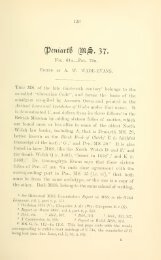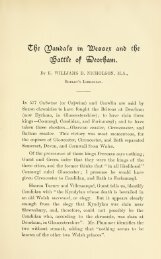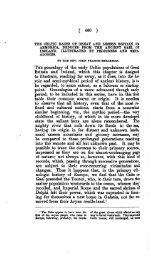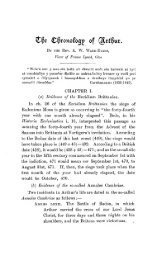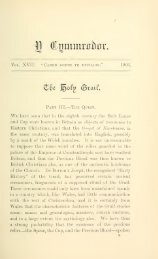An Introduction to Early Welsh - Arthur Pendragon of Wales
An Introduction to Early Welsh - Arthur Pendragon of Wales
An Introduction to Early Welsh - Arthur Pendragon of Wales
You also want an ePaper? Increase the reach of your titles
YUMPU automatically turns print PDFs into web optimized ePapers that Google loves.
THE NOUN. 23<br />
be displeased with her form.<br />
The accusative can be recognised only<br />
from the construction; in poetry the accusative <strong>of</strong> a place-name is<br />
common after verbs <strong>of</strong> motion, e.g. dywed y down Arwystli say<br />
that we will come <strong>to</strong> Arwystli MA. 192*.<br />
FORMATION<br />
OF THE PLURAL.<br />
27. A. The plural is based on Old Celtic plural<br />
formations.<br />
(a) Plural with I infection ( 7b), e.g. march horse :<br />
meirch,<br />
manach monk: meneich, maen s<strong>to</strong>ne :<br />
mein, oen lamb: wyn,<br />
asgell wing: esgyll, corn horn: cyrn, escob bishop: escyb,<br />
gwr man :<br />
gwyr.<br />
NOTE 1. This represents the old plural formation <strong>of</strong> -o- stems, e.g.<br />
meirch from *marci from *marcoi. In part, however, it might represent<br />
the plural <strong>of</strong> -i- steins, cf. Ir. suili eyes: suil eye. In dagr tear the plur.<br />
deigr = ( Ir. der) comes from *dacru, the plur. <strong>of</strong> a neut. -u- stem.<br />
NOTE 2.<br />
Many substantives which regularly form their plural otherwise,<br />
particularly such as form their plural in -ion, follow this inflexion<br />
after numerals above two, e.g. tri gweis three boys, seith meib seven sons<br />
(GC^ 283).<br />
Plural in -eu, -ieu (O.W. -ou, -iou), e.g. gen jaw: geneu,<br />
(b)<br />
penn head: penneu, cledyf sword: cledyveu, pebyll tent:<br />
pebyllyeu, glin knee glinyeu.<br />
:<br />
NOTE 3. ou, -eu started from -oues, the nom. pi. <strong>of</strong> -u- stems, cf<br />
Gaulish Lugoves.<br />
(c) Plural in -on -ion, e.g. medyc physician: medygon,<br />
cenaw whelp<br />
:<br />
cenawon, lleidr robber: lladron, mab son :<br />
meibyon, dyn man: dynyon, gelyn enemy: gelynyon.<br />
is the common ending <strong>of</strong> adjectives.<br />
This<br />
NOTE 4.<br />
morwyn maiden becomes in the plural morynyon.<br />
NOTE 5. on is based on -Ones, the nom. pi. <strong>of</strong> masc. and fern, -n- stems,<br />
cf. Gaulish Ling5nes. The borrowed lleidr robber : lladron represents an<br />
older *latri (from *latru latro) ; *latrones ;<br />
similarly dreic dragon :<br />
Seis Saxon : Saeson.<br />
dragon,<br />
(d) Other old consonantal plurals, e.g. car relative : carant<br />
(from *carants : *carantes = Ir. carae :<br />
carait), ci dog: cwn (from<br />
*kuu: *kunes), ych ox: ychen, brawt brother: broder,<br />
troet/00/: tract, ty house tei : (an old neut.-s-stem, cf. Ir. tech :




